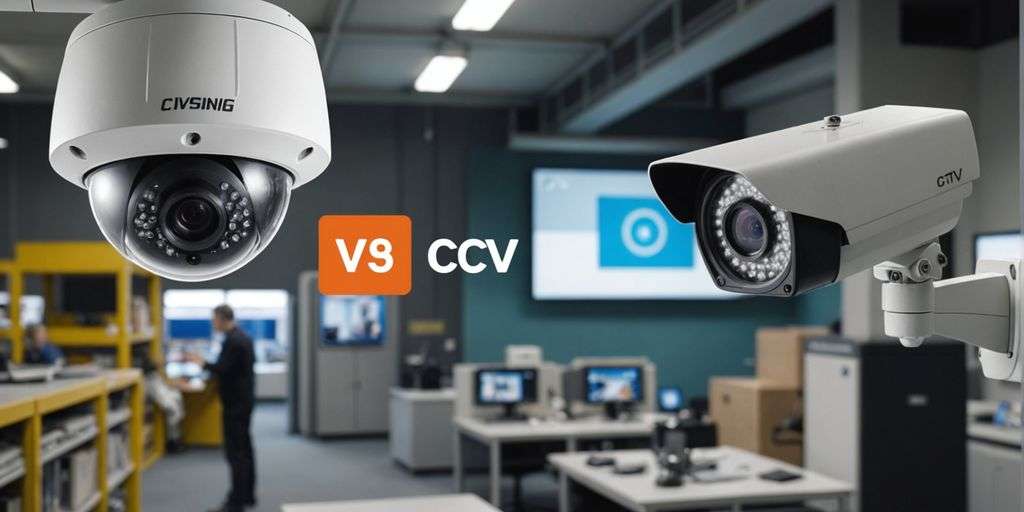Understanding Analogue CCTV Cameras

How Analogue Cameras Work
Analogue CCTV cameras capture video images using a sensor. The resolution of this sensor is typically limited to 720×575 pixels. The video is captured in 60 intervals called "fields," and two fields make up a "frame." This method is known as interlaced transmission. The video signal is then sent to a recording device through a single coaxial cable, adhering to broadcast television standards like NTSC or PAL.
Limitations of Analogue Technology
Analogue systems have several limitations. The fixed number of horizontal lines in NTSC or PAL standards caps the vertical resolution. Additionally, analogue signals can pick up noise, which can degrade the video quality. Noise can cause compression artefacts in recordings, making it harder to identify details like faces or licence plates. Moreover, analogue TV standards introduce their own imperfections, such as decoding errors that result in false colours.
Common Uses for Analogue CCTV
Despite their limitations, analogue CCTV cameras are still widely used. They are often found in older security systems and are suitable for basic surveillance needs. These cameras are commonly used in:
- Small businesses
- Residential properties
- Basic monitoring setups
Analogue CCTV systems work well for general surveillance but may not be ideal for detailed monitoring tasks.
Exploring IP CCTV Cameras
Advantages of IP Cameras
IP cameras offer a range of benefits that make them a popular choice for modern surveillance systems. One of the most significant advantages is their ability to provide high-resolution images, which ensures clearer and more detailed footage. Additionally, IP cameras can be easily integrated into existing network infrastructures, allowing for remote access and management. This means that users can monitor their security feeds from anywhere with an internet connection. Furthermore, IP cameras support advanced features such as motion detection, tampering alerts, and video analytics, enhancing the overall security capabilities.
Key Features of IP Technology
IP technology brings several key features to the table that set it apart from traditional analogue systems. These include:
- High Definition (HD) and Ultra High Definition (UHD) video quality: Ensuring superior image clarity.
- Scalability: Easily add more cameras to the system without significant changes to the infrastructure.
- Power over Ethernet (PoE): Simplifies installation by allowing both power and data to be transmitted through a single cable.
- Remote access: View and manage cameras from any location via the internet.
- Advanced video analytics: Features like facial recognition, object tracking, and behavioural analysis.
Common Applications for IP CCTV
IP CCTV systems are versatile and can be used in various settings. Some common applications include:
- Commercial properties: Retail stores, offices, and warehouses benefit from the high-resolution footage and remote monitoring capabilities.
- Residential areas: Homeowners use IP cameras for enhanced security and peace of mind.
- Public spaces: Parks, streets, and transportation hubs utilise IP CCTV for improved public safety.
- Industrial sites: Factories and construction sites employ IP cameras to monitor operations and ensure worker safety.
IP cameras offer a flexible and scalable solution for modern surveillance needs, making them an ideal choice for a wide range of applications.
Comparing Analogue and IP CCTV Systems
Image Quality and Resolution
When it comes to image quality, IP cameras generally offer superior resolution compared to analogue cameras. Analogue cameras are often limited to standard definition, while IP cameras can provide high-definition (HD) and even ultra-high-definition (UHD) images. This means clearer and more detailed footage, which is crucial for identifying faces or licence plates.
Installation and Maintenance
Installing analogue CCTV systems typically involves running coaxial cables from each camera to a central recording device. This can be labour-intensive and costly. On the other hand, IP cameras use Ethernet cables, which can also carry power (Power over Ethernet or PoE), simplifying the installation process. Maintenance for IP systems is often easier as well, thanks to remote access capabilities that allow for troubleshooting without needing to be on-site.
Cost Considerations
While the initial cost of IP cameras can be higher, they often prove more cost-effective in the long run. Analogue systems may have lower upfront costs, but they require more cabling and are less flexible. IP systems, with their higher resolution and easier maintenance, can offer better value over time.
Choosing between analogue and IP CCTV systems depends on your specific needs and budget. Analogue systems might be suitable for smaller, less critical applications, while IP systems are ideal for larger, more complex installations requiring high-quality footage and remote access.
Making the Right Choice for Your Needs
Choosing between analogue and IP CCTV systems can be challenging. This section will guide you through the process of making an informed decision based on your specific needs.
Conclusion
In the end, choosing between analogue and IP CCTV systems boils down to your specific needs and circumstances. Analogue systems, with their simplicity and lower cost, might be suitable for smaller, less complex installations. On the other hand, IP systems offer superior image quality, scalability, and advanced features that are ideal for larger or more demanding environments. As technology continues to evolve, IP systems are becoming more accessible and affordable, making them a viable option for a wider range of applications. Whichever path you choose, understanding the strengths and limitations of each technology will help you make an informed decision that best suits your security needs.
Frequently Asked Questions
What is the main difference between analogue and IP CCTV cameras?
Analogue CCTV cameras send video as a continuous signal through a coaxial cable, while IP cameras convert video into digital data and send it over a network.
Which type of CCTV camera offers better image quality?
IP cameras generally provide better image quality and higher resolution compared to analogue cameras.
Are IP CCTV systems more expensive than analogue systems?
Yes, IP CCTV systems tend to be more expensive initially, but they offer more features and can be more cost-effective in the long run due to easier installation and better scalability.





